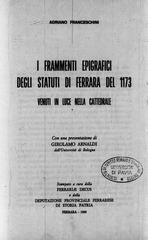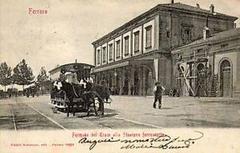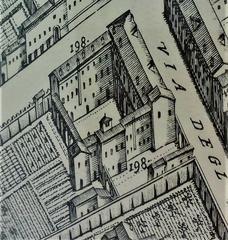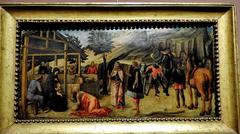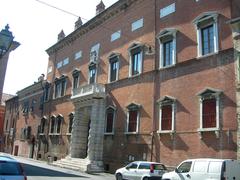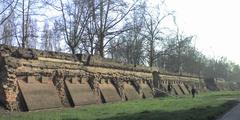Visiting Chiesa del Gesù Ferrara, Italy: Complete Guide
Date: 04/07/2025
Introduction
Situated in the heart of Ferrara, Italy, the Chiesa del Gesù is a profound testament to Jesuit spirituality, Renaissance innovation, and the city’s rich cultural heritage. Established in the late 16th century during the era of the Catholic Counter-Reformation, this church was conceived to embody the Jesuit ideals of clarity in worship, educational outreach, and artistic engagement. Its architecture, inspired by Il Gesù in Rome, features a single nave flanked by chapels, a luminous dome, and understated decorative elements that reflect the Jesuit mission and Renaissance traditions. The church houses significant artworks, most notably Guido Mazzoni’s dramatic “Compianto sul Cristo Morto,” which ties the site to Ferrara’s Este dynasty and the city’s artistic legacy.
Today, Chiesa del Gesù remains an active place of worship and a cultural landmark. Visitors are drawn not only by its architectural features and art but also by its central location near Ferrara’s essential historical sites, including the Estense Castle and Palazzo dei Diamanti. This guide provides a comprehensive overview of the church’s history, architecture, practical visiting information, and tips to enrich your experience (arsartisticadventureofmankind.wordpress.com; Wikipedia; Ferrara Terra e Acqua).
Historical Overview
Origins and Foundation
Chiesa del Gesù was established in the late 16th century as part of the Jesuit order’s expansion in Ferrara. The Jesuits, founded in 1540 by Ignatius of Loyola, quickly became influential across Europe, focusing on education and religious reform. The church was designed as the principal Jesuit seat in Ferrara, modeled after Il Gesù in Rome, with the support of local nobility and ecclesiastical authorities (arsartisticadventureofmankind.wordpress.com).
Architectural Evolution
Design and Influences
Chiesa del Gesù’s design was strongly influenced by the architectural principles established by Giacomo Barozzi da Vignola for Il Gesù in Rome. Its single nave, flanked by chapels and crowned by a dome, was intended to enhance acoustics and visibility for preaching—a direct response to Counter-Reformation liturgical needs (architecture.edwardworthlibrary.ie). The church’s spatial arrangement promotes clarity and congregation participation, hallmarks of Jesuit worship.
Façade and Decorative Approach
The brick façade, completed after the main structure, is intentionally sober, reflecting the Jesuit ideal of humility and spiritual focus. Drawing on Renaissance influences such as Alberti’s Santa Maria Novella, the façade’s two-tiered composition, restrained ornamentation, and use of pilasters and a pediment express both Renaissance harmony and the emerging Baroque aesthetic (arsartisticadventureofmankind.wordpress.com; Wikipedia).
Interior Layout
Inside, the church features a single, vaulted nave with chapels set between supporting buttresses. The dome at the crossing bathes the central space in natural light. This arrangement enhances both acoustics and visual focus, in line with Jesuit priorities for clarity in liturgy (arsartisticadventureofmankind.wordpress.com). Although much of the original interior decoration was lost, the church remains an impressive example of Renaissance ecclesiastical architecture.
Cultural and Religious Role
The church was a center of Jesuit activity—educational, religious, and social—until the order’s suppression in 1773. It continued to serve the community under successive religious orders and has survived periods of neglect, restoration, and wartime damage.
Architectural Features
Exterior
Chiesa del Gesù’s exposed brick façade is a defining feature, intentionally avoiding ornate Baroque flourishes in favor of Renaissance simplicity. Its location at Via Borgoleoni 56, within Biagio Rossetti’s Addizione Erculea urban development, underscores its significance in Ferrara’s Renaissance landscape (Inferrara).
Interior
The church’s single nave is flanked by six interconnected chapels. Despite losses from World War II bombings that destroyed many original wall paintings, the interior retains a sense of solemnity thanks to its vaulted ceilings, spacious nave, and surviving artworks (Wikipedia; Monumenti Aperti).
Artistic Highlights
Guido Mazzoni’s “Compianto sul Cristo Morto”
The church’s artistic heart is Guido Mazzoni’s “Compianto sul Cristo Morto” (Lamentation over the Dead Christ), a polychrome terracotta group created before 1485 (Ferrara Terra e Acqua; Monumenti Aperti). This emotionally intense work, relocated from the demolished Santa Maria della Rosa, features realistic figures, some believed to be portraits of Este patrons.
Monument to Barbara d’Austria
Behind the main altar is the funerary monument of Barbara d’Austria, wife of Duke Alfonso II d’Este (Ferrara Terra e Acqua), reflecting the church’s connections to the Este dynasty.
Paintings and Altarpieces
- Annunciazione by Il Bastarolo (c. 1585), found in the first chapel on the right (Wikipedia).
- Works by Giuseppe Maria Crespi, including Communion of St. Stanislaus Kostka and Miracle of St. Francis Xavier, are notable for their dynamic Baroque style (Wikipedia).
Restoration and Preservation
After the Jesuits’ suppression in 1773, the church was managed by the Somaschi Fathers and served various civic roles. The Jesuits returned in 1847, remaining until 1979. World War II damages led to extensive restoration, particularly focused on stabilizing the structure and preserving Mazzoni’s terracotta group (Wikipedia).
Visitor Information
Location and Accessibility
Chiesa del Gesù is centrally located at Via Borgoleoni 56, within easy walking distance of major attractions like Estense Castle and Ferrara Cathedral. The church is fully accessible, with ramps for wheelchairs and strollers (Ferrara OFF).
Opening Hours (as of July 2025)
- Saturday: 10:00 AM – 5:30 PM
- Sunday: 1:30 PM – 5:30 PM
- Closed on weekdays except for special events or religious ceremonies.
Hours may vary during holidays or cultural events; check ahead for updates.
Admission
- Entry is free; donations are welcome.
- Guided tours (free, every 15 minutes during opening hours) offer insights into the church’s art and history (Ferrara OFF).
- Larger groups should arrange visits in advance.
Visitor Services
- On-site staff and printed materials are available.
- Restrooms are located nearby in the city center, not inside the church.
Dress Code and Etiquette
Modest dress is required; cover shoulders and knees, remove hats, and maintain silence, especially during services.
Best Times to Visit
Early Saturday mornings or Sunday afternoons offer a quieter experience.
Nearby Attractions
- Castello Estense
- Palazzo dei Diamanti
- Via delle Volte
The surrounding area is filled with cafés and shops for a complete cultural experience (The Travel Folk).
Photography Tips
Photography is allowed (no flash). The best photo opportunity is in the side chapel featuring Mazzoni’s terracotta group. Avoid photography during services and tours to respect the space.
Frequently Asked Questions (FAQ)
Q: Is there an entrance fee?
A: No, admission is free; donations are welcome.
Q: Are guided tours available?
A: Yes, free tours operate during opening hours.
Q: Is the church accessible to people with disabilities?
A: Yes, ramps and accessible facilities are available.
Q: Can I visit on weekdays?
A: Regular public hours are on weekends; check for special events or openings.
Q: Can I take photos inside?
A: Yes, but no flash; be respectful during services.
Q: What are the must-see artworks?
A: Mazzoni’s “Compianto sul Cristo Morto” and altarpieces by Il Bastarolo and Crespi.
Q: Where are the nearest restrooms?
A: In the city center, near the church.
Summary and Final Tips
Chiesa del Gesù offers a blend of spiritual gravitas, Renaissance architectural beauty, and exceptional art. Its accessible location, free admission, and proximity to Ferrara’s major sights make it a highlight for any visitor. Enhance your experience with guided tours, and plan your itinerary to include other landmarks for a comprehensive view of Ferrara’s rich cultural and religious legacy.
Contact and Further Resources
- Ferrara Infopoint: Piazza Trento Trieste, tel: +39 327 7537900
- Official Event Page: Ferrara OFF – Chiesa del Gesù
- Ferrara Tourism Portal: Ferrara Today – Events
For up-to-date information, download the Audiala app and follow us on social media for exclusive content and travel tips.
References and Further Reading
- Italian Architecture During the XVIth Century: The Church of the Gesù and the Apostolic Palace
- Jesuit Churches and Architecture
- Chiesa del Gesù (Ferrara), Wikipedia
- Chiesa del Gesù (Ferrara), Wikipedia Italian
- Chiesa del Gesù Ferrara, Inferrara
- Chiesa del Gesù Ferrara, Monumenti Aperti
- Chiesa del Gesù Ferrara, Ferrara Terra e Acqua
- In faciem loci: La chiesa dei Gesuiti a Ferrara tra storia e realtà costruttiva, Academia.edu
- Visiting Chiesa del Gesù Ferrara, Ferrara OFF
- Ferrara Today – Events
- The Crazy Tourist – 15 Best Things to Do in Ferrara, Italy
- The Travel Folk – Things to Do in Ferrara, Italy
